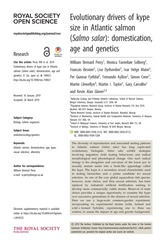| dc.contributor.author | Perry, William | |
| dc.contributor.author | Solberg, Monica Favnebøe | |
| dc.contributor.author | Besnier, Francois | |
| dc.contributor.author | Dyrhovden, Lise | |
| dc.contributor.author | Matre, Ivar Helge | |
| dc.contributor.author | Fjelldal, Per Gunnar | |
| dc.contributor.author | Ayllon, Fernando | |
| dc.contributor.author | Creer, Simon | |
| dc.contributor.author | Llewellyn, Martin | |
| dc.contributor.author | Taylor, Martin I. | |
| dc.contributor.author | Carvalho, Gary | |
| dc.contributor.author | Glover, Kevin | |
| dc.date.accessioned | 2020-02-07T12:58:40Z | |
| dc.date.available | 2020-02-07T12:58:40Z | |
| dc.date.issued | 2019-04-17 | |
| dc.Published | Perry W, Solberg MF, Besnier F, Dyrhovden L, Matre IH, Fjelldal PG, Ayllon F, Creer S, Llewellyn M, Taylor MI, Carvalho, Glover KA. Evolutionary drivers of kype size in atlantic salmon (salmo salar): domestication, age and genetics. Royal Society Open Science. 2019;6(4):190021 | eng |
| dc.identifier.issn | 2054-5703 | en_US |
| dc.identifier.uri | http://hdl.handle.net/1956/21376 | |
| dc.description.abstract | The diversity of reproduction and associated mating patterns in Atlantic salmon (Salmo salar) has long captivated evolutionary biologists. Salmo salar exhibit strategies involving migration, bold mating behaviours and radical morphological and physiological change. One such radical change is the elongation and curvature of the lower jaw in sexually mature males into a hook-like appendage called the kype. The kype is a secondary sexual characteristic used in mating hierarchies and a prime candidate for sexual selection. As one of the core global aquaculture fish species, however, mate choice, and thus sexual selection, has been replaced by industrial artificial fertilization seeking to develop more commercially viable strains. Removal of mate choice provides a unique opportunity to examine the kype over successive generations in the absence of sexual selection. Here we use a large-scale common-garden experiment, incorporating six experimental strains (wild, farmed and wild × farmed hybrids), experiencing one to three sea winters, to assess the impact of age and genetic background. After controlling for allometry, fork length-adjusted kype height (AKH) was significantly reduced in the domesticated strain in comparison to two wild strains. Furthermore, genetic variation at a locus on linkage group SSA1 was associated with kype height, and a locus on linkage group SSA23 was associated with fork length-adjusted kype length (AKL). The reduction in fork length-AKH in domesticated salmon suggests that the kype is of importance in mate choice and that it has decreased due to relaxation of sexual selection. Fork length-AKL showed an increase in domesticated individuals, highlighting that it may not be an important cue in mate choice. These results give us insight into the evolutionary significance of the kype, as well as implications of genetic induced phenotypic change caused by domesticated individuals escaping into the natural environment. | en_US |
| dc.language.iso | eng | eng |
| dc.publisher | The Royal Society Publishing | en_US |
| dc.rights | Attribution CC BY | eng |
| dc.rights.uri | http://creativecommons.org/licenses/by/4.0 | eng |
| dc.subject | Atlantic salmon | eng |
| dc.subject | domestication | eng |
| dc.subject | age | eng |
| dc.subject | kype | eng |
| dc.subject | sexual selection | eng |
| dc.subject | allometry | eng |
| dc.title | Evolutionary drivers of kype size in atlantic salmon (salmo salar): domestication, age and genetics | en_US |
| dc.type | Peer reviewed | |
| dc.type | Journal article | |
| dc.date.updated | 2019-08-20T11:26:49Z | |
| dc.description.version | publishedVersion | en_US |
| dc.rights.holder | Copyright 2019 The Author(s) | en_US |
| dc.identifier.doi | https://doi.org/10.1098/rsos.190021 | |
| dc.identifier.cristin | 1714814 | |
| dc.source.journal | Royal Society Open Science | |
| dc.relation.project | Norges forskningsråd: 200510 | |

